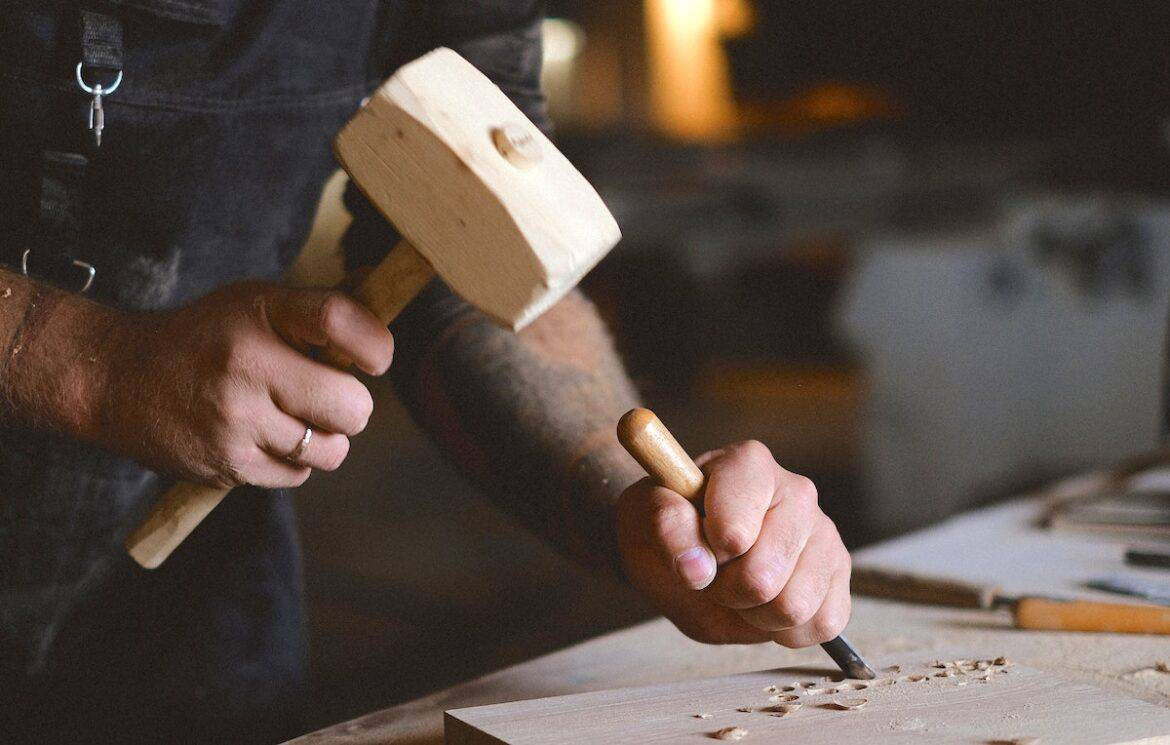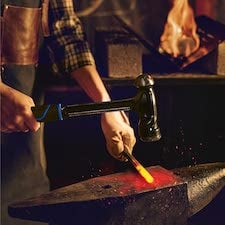Mallets and hammers are indispensable tools for nearly all handiwork. There is always something that needs striking, pounding, splitting or crushing.
Regardless of whether you are crafting with leather, wood, or metal, you will need either a hammer or a mallet, sometimes both. For many new and even experienced crafters, these terms are taken to mean the same thing, but are they?
Not quite. The nature of their job is very similar, but these are two different tools. There’s a subtle yet profound difference that makes a mallet better suited for particular applications than a hammer and vice versa.
What is the difference between a hammer and a mallet? The difference between a hammer and a mallet is in the shape of the head. Hammers are better suited for tasks such as pounding nails into tough objects, while mallets have a larger surface area to deliver a lighter force and are used for working with materials like leather and softwood.
If you are one among many who could never make a clear distinction between them, then this is the article for you. We’ll explain everything there is to know about these two endlessly useful tools.
What Is The Difference Between A Hammer And A Mallet?
Before we go to the differences between a hammer and a mallet, let’s first look at their definitions.
What is a hammer? A hammer is one of the most basic hand tools found in toolboxes at home and in commercial settings. It consists of a heavy-weighted head attached to a handle at a right angle to the shaft.
A hammer is used for pounding or striking heavily on smaller tools and fasteners to drive them directly into surfaces or objects. It can also be used to shape or crush objects.
What is a mallet? A mallet is another driving tool resembling a hammer. It has a block or barrel-shaped head with a crosswise handle. Like a hammer, it is struck on other tools or surfaces to impart a mild to moderate force. It is used similarly to a hammer but with lighter or softer materials.
It is this fine line between how these two tools function that makes them seem the same. Let’s go over the actual variations to make a clear distinction between a hammer and a mallet.
1. Construction Materials
A hammer is a heavy impact tool. Consequently, its head is often made of robust metal. High carbon steel or steel alloys, to be precise. The steel head usually undergoes heat treatment to be extra resilient. It will not chip away even after extended use.
The shaft can be wooden or made of solid plastic. Sometimes the wood or plastic shaft is rubberized to provide traction and a firmer grip. Wood is an excellent shock absorber. It minimizes recoil shock waves from radiating to the hand. Plastic is also good at that, but not better than wood.
On the other hand, a typical mallet will be constructed of wood from head to shaft. Notwithstanding, there are a couple of other materials that are used to make the mallet’s head.
A rubber mallet is just as common as a wooden one. You’ll also find mallets made of soft metals like copper, iron, brass, or aluminum. Plastic mallets made from polycarbonate, fiberglass, or nylon, and rawhide are less common but are an option too.
If you’ve been keen, you must have noticed that the materials available for the mallet head are much softer. That’s because a mallet is designed for less harsh impacts. The choice of material for the head is purposeful not to mar the object being pounded.
2. Shape
Another critical difference between a mallet and a hammer is in the shape of the head. While there are several types of mallets and hammers depending on the material, they all typically have a uniform barrel, or block-shaped head fixed on a handle.
Carver’s Mallet
The carver’s mallet is usually carved out of a single piece of wood with no joining.
But what makes this mallet stand out from the rest is that the barrel head sits vertically, in other words, in line with the handle.
Therefore the face is the rounded part of the cylindrical head.
Dead Blow Mallet
The dead blow mallet is shaped like any regular mallet except that it is not built all solid. The inside is a hollow cavity filled with loose sand or metal shots (small spherical steel balls).
This construction style delivers a higher impact than wood or rubber mallets without rebounding or deforming the object being pounded.
Ball-Peen Hammer
A ball-peen hammer, as the name suggests, has a rounded end and a flat one. The flat end drives in nails or other tools, while the orbed back primarily flattens metals.
I really like this hammer on Amazon for metalworking.
Claw Hammer
A claw hammer is the most ubiquitous type of hammer. It is the standard picture of what a hammer is to most people.
The head is smooth and flat at the front and clawed at the other end. The claw is used to remove nails, while the flat front is for hitting and driving in nails or other fasteners.
It is most commonly utilized in woodworking but can be employed in a vast array of workforces.
Framing/Rip Hammer
This type of hammer is very similar to a claw hammer, except that the claws are straightened instead of curved.
Also, its face is texturized to deter the head from slipping when hitting smaller tools. You’ll also find it heavier with an elongated shaft.
To get a better idea of the difference between a rip claw hammer and a curved claw hammer, watch this video by The Honest Carpenter on YouTube.
Sledgehammer
A sledgehammer looks more like a mallet, except it is metallic and heavy-duty. It has a barrel-shaped head and is extremely heavy with a very long handle.
This type of hammer produces an extremely heavy hit. Its swing comes with very high momentum and is used for crushing stones, rocks and demolishing concrete walls. It is wielded with two hands.
Drywall Hammer
A drywall hammer has a flat waffled front face and a hatchet-shaped back end. It is employed when putting up or taking down drywall.
The serrated front face is used to drive in nails while the back cuts and tears into drywall or wood and also pulls mispositioned nails out.
Roofing Hammer
The roofing hammer is one of the more uniquely shaped hammers. It is triple-sided, which makes it really versatile even though it is best for roofing shingles.
At the front of the head is a smooth or rugged flat face, while the back end has a spike or pick for piercing holes in the slates and a fork for extracting nails.
3. The Applications
This is perhaps the most confusing thing when you think of a mallet vs hammer in that people never know what tool to use, when, or where. They’re both driving tools, yet the design, material, and even weight dictate what you can and cannot use each type of tool for.
When Do You Use A Mallet?
A mallet produces a softer impact and can therefore be used when working with wood, leather, soft metal sheets, and light construction works or driving any tool that doesn’t need to go too deep.
Wooden mallets are great for driving dowels or chisels when carving wood. They also aid in knocking two pieces of wood together for tighter joints. Rubber mallets are helpful when you want to form metal sheets without causing indentation. They are also used in upholstery to drive in tiny nails.
You can use rubber mallets when installing tiles on surfaces like plasterboard and laminae. Mallets are a leather workers’ favorite tool when stamping or carving leather. Metalsmiths and jewelers also utilize a mallet in similar ways; to stamp or manipulate the shape of delicate pieces.
Metal mallets are common options in automotive and machinery applications. They are better suited for hitting metal without resulting in sparks and also denting the appearance. Mallets are generally best for small and medium crafting and other non-industrial applications.
When Can You Use A Hammer?
You can use a hammer in any scenario that requires a significant amount of impact, for example, driving fasteners deep and bending or breaking rigid material.
The conventional hammer is typically used when striking nails into wood, drywall, and other surfaces or prying them up and out.
We already discussed the various uses of specialty hammers in the second part of this post. Specialty hammers will do the job of a standard hammer and other tasks it is designed explicitly for, depending on the shape of the head.
The use of hammers is on a broad spectrum of home and industrial activities from roofing to masonry, geology, mining, woodworking, welding, upholstery, and many more. You can choose the appropriate one to pound, cut through, or crush a variety of materials.
You probably by now have already seen the different aspects of a mallet vs hammer. The two driving tools appear so similar yet are so unique.
Conclusion
Mallets are driving tools designed for light impact pounding without distorting objects. Hammers are built for heavy striking, which is necessary for tough jobs.
Mallets are classified by material, with wood and rubber mallets being the most common. You’ll also find plastic, brass, copper, and aluminum mallets.
Hammers are classified by the shape of the head since they are all made of steel. A standard one has one flat side and a clawed side. Specialty hammers are different. They can be picked, chiseled, or dome-shaped on one end and sometimes a combination.
With this clear distinction, we hope you can now choose the right tool for the type of task, trade, or craft you are undertaking.
Up Next: 7 Best Woodworking Kits For Beginners


